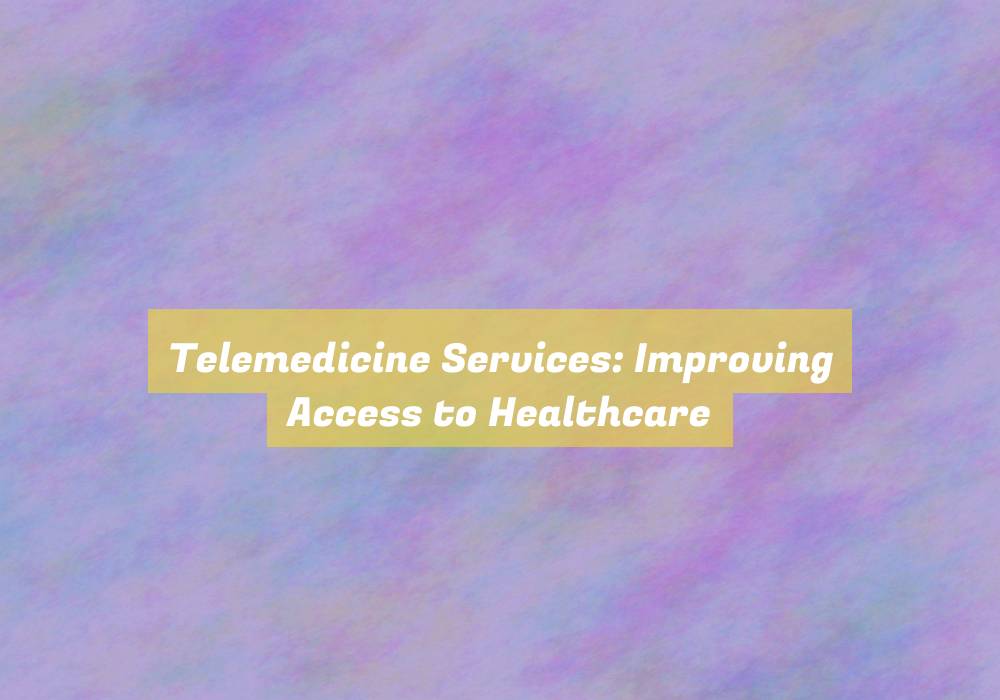Telemedicine Services: Improving Access to Healthcare
As technology advances, so does the way you access healthcare. Telemedicine services are revolutionizing the healthcare industry, providing you with the opportunity to consult with medical professionals from the comfort of your own home.
But what exactly is telemedicine, and how does it work?
LetG??s explore the impact of telemedicine services on improving access to healthcare and the potential it holds for the future of medicine.
The Evolution of Telemedicine
The evolution of telemedicine has transformed the way healthcare is delivered, revolutionizing access to medical services for patients worldwide. Initially, telemedicine primarily involved consultations via video conferencing. However, as technology advanced, so did telemedicine. It now encompasses a wide array of services such as remote monitoring of vital signs, virtual consultations with specialists, and even the use of artificial intelligence for preliminary diagnosis.
As technology continues to progress, telemedicine is becoming more sophisticated. Innovations in wearable devices and smartphone applications allow patients to monitor their health in real-time and share this data with healthcare providers. Moreover, the integration of telemedicine into electronic health records has streamlined the entire process, making it easier for healthcare providers to access and analyze patient data remotely.
The evolution of telemedicine has also led to the rise of telehealth platforms, which connect patients with healthcare providers 24/7, offering convenience and timely access to medical advice. Additionally, the increasing acceptance and regulation of telemedicine by healthcare institutions and insurance providers have further propelled its evolution, making it an integral part of modern healthcare delivery.
Advantages of Telemedicine Services
With the evolution of telemedicine expanding the scope of healthcare delivery, itG??s important to highlight the numerous advantages of telemedicine services.
Firstly, telemedicine enhances access to medical care, especially for individuals residing in remote or rural areas. It allows patients to connect with healthcare providers without the need for lengthy travel, thereby reducing time and costs.
Additionally, telemedicine facilitates timely medical interventions, enabling patients to receive quick consultations and treatment without prolonged waiting periods. Furthermore, it promotes continuity of care by enabling healthcare professionals to monitor and manage chronic conditions remotely, leading to improved patient outcomes.
Moreover, telemedicine offers convenience and flexibility, allowing patients to schedule appointments at their convenience, reducing disruptions to work and personal commitments. It also plays a vital role in reducing the spread of infectious diseases by minimizing in-person contact, particularly during health crises.
Overcoming Healthcare Barriers
To improve healthcare access, itG??s crucial to address the barriers that hinder patients from receiving necessary medical care.
One significant barrier is the geographical distance between patients and healthcare facilities. Many people, especially in rural areas, have limited access to medical services due to the scarcity of healthcare providers in their vicinity. Telemedicine can bridge this gap by allowing patients to consult with healthcare professionals remotely, thereby overcoming the challenge of distance.
Another barrier is the high cost of healthcare. For some individuals, seeking medical treatment can be financially burdensome, leading them to forgo necessary care. Telemedicine services can provide a more cost-effective alternative, as virtual consultations tend to be more affordable than traditional in-person visits. Additionally, telemedicine can reduce indirect costs such as transportation and time off work.
Language and cultural barriers also pose challenges to accessing healthcare. Some patients may struggle to communicate effectively with healthcare providers due to language differences or cultural misunderstandings. Telemedicine platforms can offer language interpretation services and connect patients with healthcare professionals who understand their cultural backgrounds, promoting better communication and understanding.
Future Trends in Telemedicine
Embracing innovative technology is essential for advancing telemedicine services and meeting the evolving healthcare needs of diverse populations.
One future trend in telemedicine is the integration of artificial intelligence (AI) to enhance diagnostic accuracy and treatment recommendations. AI algorithms can analyze vast amounts of patient data, enabling healthcare providers to make more informed decisions.
Additionally, virtual reality (VR) and augmented reality (AR) are poised to revolutionize medical training and patient education. Through VR and AR, medical professionals can simulate complex surgical procedures and patients can receive immersive, interactive education about their health conditions.
Furthermore, the Internet of Things (IoT) is expected to play a significant role in telemedicine by enabling remote monitoring of patientsG?? vital signs and health parameters. This real-time data can facilitate early intervention and personalized care plans.
Another emerging trend is the use of blockchain technology to ensure the security and integrity of telemedicine data, providing patients and healthcare providers with confidence in the privacy and accuracy of medical records.
Conclusion
In conclusion, telemedicine services are revolutionizing healthcare by improving access for patients.
With the evolution of technology, telemedicine has become more convenient and accessible, breaking down barriers such as distance and time.
The advantages of telemedicine are clear, as it allows for remote consultations, monitoring, and treatment.
As telemedicine continues to advance, it will play a significant role in the future of healthcare, providing efficient and effective care for patients worldwide.






